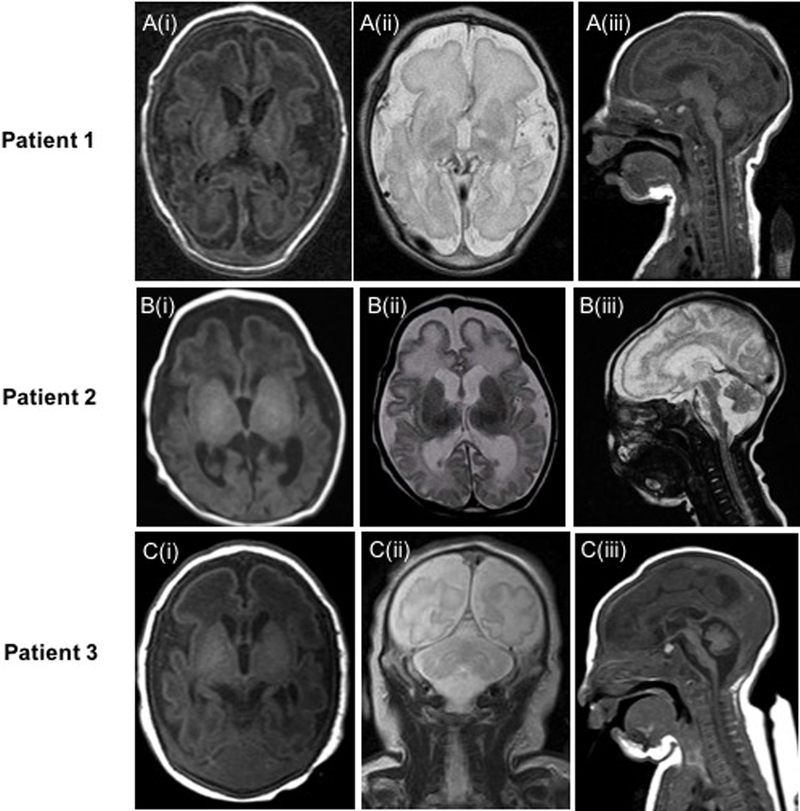Asparagine synthetase deficiency (ASNSD, MIM 615574) is a recently delineated rare neurometabolic disorder caused by mutations in ASNS (MIM 108370) (Ruzzo et al., 2013). It is characterized by congenital and/or postnatal progressive microcephaly, global developmental delay, seizures, growth retardation, cerebral atrophy and simplified gyral pattern. We hereby describe four novel variations ascertained by exome sequencing in three individuals from three unrelated families (Figure S1). We summarize the genotype and phenotype of 22 individuals from 14 families with 16 mutations in ASNS (Alfadhel et al., 2015, Ben-Salem et al., 2015, Gataullina et al., 2016, Gupta et al., 2017, Palmer et al., 2015, Ruzzo et al., 2013, Seidahmed et al., 2016, Sun et al., 2016, Yamamoto et al., 2017). Informed consents from the families were obtained for the study. The study was approved by the Institutional Ethics Committee. Detailed clinical information, exome sequencing methodology and analysis are provided as supplementary information.
All three individuals showed congenital microcephaly, progressive post-natal microcephaly and spasticity whereas seizures were noted only in patients 1 and 3 (Supplementary table 1). Magnetic resonance imaging of brain revealed simplified gyral pattern, cerebral atrophy and ponto-cerebellar hypoplasia in all (Figure 1). WES analysis in patient 1, revealed a novel homozygous missense variant, c.1211G>A [p.(Arg404His)] in exon 10 of ASNS gene. Analysis of patient 2 disclosed novel compound heterozygous variants, c.224A>G [p.(Asn75Ser)] in exon 3 and c.413A>C [p.(Asp138Ala)] in exon 4 of ASNS gene. In patient 3, a novel homozygous variant, c.1649G>A [p.(Arg550His)] was observed. These variants are not present in either homozygous or heterozygous states in databases of normal population. These variants are also not observed in our in-house database of 357 families. These variants occur at a highly conserved region and predicted as damaging to ASNS protein function. Further analysis by in silico or any other functional assay could not be performed for these variants.
Figure 1:

(A) Brain magnetic resonance imaging (MRI) of patient 1 taken on day 2 of life. Axial T1 (i), axial T2 (ii) and sagittal T1 (iii) weighted images show microcephaly with overlapping of sutures, simplified gyral pattern, delayed myelination, reduced volume of the pons and mild cerebral atrophy are observed. (B) Brain MRI images of patient 2 taken at 1 month of age. Axial T1 (i), axial T2 (ii) and sagittal T2 (iii) weighed images show microcephaly with overlapping sutures, mild delayed myelination, reduced size of the pons and cerebral atrophy are observed. (C) Brain MRI images of patient 3 on day 2 of life. Axial T1 (i), coronal T2 (ii) and sagittal T1 (iii) weighted images show microcephaly with overlapping of sutures, simplified gyral pattern, reduced volume of the pons and cerebral atrophy are observed.
A review of 25 individuals including our patients revealed significant global developmental delay (22/23) in most individuals. Congenital microcephaly and simplified gyral pattern on brain imaging was evident in a significant proportion (19/25) of individuals. Other frequent brain imaging findings were ponto-cerebellar hypoplasia/reduced pons size (16/25) and progressive cerebral atrophy seen in all the individuals. Spastic quadraparesis (19/24) and seizures (18/25) are the other common findings in individuals with ASNSD (Supplementary table 1). High degree of inbreeding observed in the local population is the possible cause of homozygous variants in non-consanguineous families in our study.
We herein emphasize the utility of whole exome sequencing as an important tool in delineating the genetic etiology in individuals with rare and clinically heterogeneous phenotypes. We also add four novel mutations, thus expanding the ASNS mutation spectrum. The presence of variable degree of congenital microcephaly underscores that this condition should be considered among the various genetic disorders presenting with primary microcephaly.
Supplementary Material
Acknowledgements
We thank the families who consented for participation in this study. This study was supported by National Institutes of Health funded the project titled ‘Genetic Diagnosis of Heritable Neurodevelopmental Disorders in India: Investigating the Use of Whole-Exome Sequencing and Genetic Counseling to Address the High Burden of Neurodevelopmental Disorders’ (1R21NS094047-01).
Footnotes
Disclosures
Authors declare no conflict of interest.
References
- Alfadhel M, Alrifai MT, Trujillano D et al. (2015) Asparagine Synthetase Deficiency: New Inborn Errors of Metabolism. JIMD reports 22: 11–6. [DOI] [PMC free article] [PubMed] [Google Scholar]
- Ben-Salem S, Gleeson JG, Al-Shamsi AM et al. (2015) Asparagine synthetase deficiency detected by whole exome sequencing causes congenital microcephaly, epileptic encephalopathy and psychomotor delay. Metabolic brain disease 30: 687–94. [DOI] [PMC free article] [PubMed] [Google Scholar]
- Gataullina S, Lauer-Zillhardt J, Kaminska A et al. (2016) Epileptic Phenotype of Two Siblings with Asparagine Synthesis Deficiency Mimics Neonatal Pyridoxine-Dependent Epilepsy. Neuropediatrics 47: 399–403. [DOI] [PubMed] [Google Scholar]
- Gupta N, Tewari VV, Kumar M et al. (2017) Asparagine Synthetase deficiency-report of a novel mutation and review of literature. Metabolic brain disease [DOI] [PubMed]
- Palmer EE, Hayner J, Sachdev R et al. (2015) Asparagine Synthetase Deficiency causes reduced proliferation of cells under conditions of limited asparagine. Molecular genetics and metabolism 116: 178–86. [DOI] [PMC free article] [PubMed] [Google Scholar]
- Ruzzo EK, Capo-Chichi JM, Ben-Zeev B et al. (2013) Deficiency of asparagine synthetase causes congenital microcephaly and a progressive form of encephalopathy. Neuron 80: 429–41. [DOI] [PMC free article] [PubMed] [Google Scholar]
- Seidahmed MZ, Salih MA, Abdulbasit OB et al. (2016) Hyperekplexia, microcephaly and simplified gyral pattern caused by novel ASNS mutations, case report. BMC neurology 16: 105. [DOI] [PMC free article] [PubMed] [Google Scholar]
- Sun J, McGillivray AJ, Pinner J et al. (2016) Diaphragmatic Eventration in Sisters with Asparagine Synthetase Deficiency: A Novel Homozygous ASNS Mutation and Expanded Phenotype. JIMD Rep [DOI] [PMC free article] [PubMed]
- Yamamoto T, Endo W, Ohnishi H et al. (2017) The first report of Japanese patients with asparagine synthetase deficiency. Brain & development 39: 236–242. [DOI] [PubMed] [Google Scholar]
Associated Data
This section collects any data citations, data availability statements, or supplementary materials included in this article.


